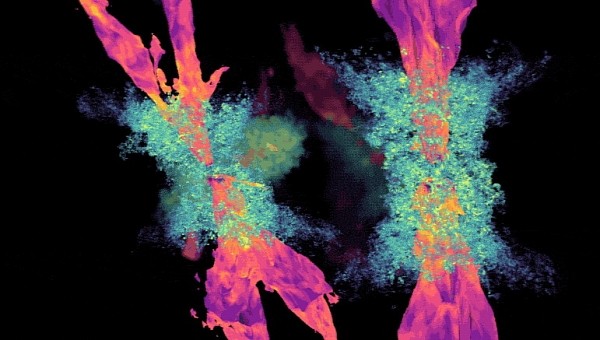Black holes are perhaps the most mystifying, naturally occurring phenomenon in the universe known to modern science. For all that mankind marvels at their destructive power through their portrayal in films and TV. NASA supercomputers are painting an image that's somehow even more terrifying.
The last time NASA reported on what they were up to with their flagship Discover-class supercomputer, it was creating detailed 3D animations of the astronomical collision between the Earth, and another heavenly body scientists believe created the moon billions of years ago. If you thought that was positively bonkers, just check out what it's been up to since then. Courtesy of NASA's Goddard Space Flight Center, we were able to find out.
Though black holes have a reputation for being points of gravitational pull so strong that not even light itself can escape. Oh, and it'll turn all your internal organs into the finest Italian space-spaghetti, sans-marinara if you venture too close to one. The problematic thing about that is it's not always entirely accurate. For reasons NASA scientists are still trying to understand, sometimes black holes do a downside more than just gobble space junk up that passes its course.
On occasion, a black hole will essentially experience the cosmological equivalent of a bad case of indigestion. Although when the average person eats a meal with too much garlic, they don't churn out nearly the same level of raw energy as the super-massive black holes at the center of a number of galaxies, including the Milkey Way.
As is shown by an animation created by the results of over 100 NASA supercomputer simulations, cosmic material swallowed by a black hole has the potential to be shot back out into deep space as beams of cosmic radiation traveling more or less at the speed of light. Be it crushed-up bits of planets, active stars, cosmic dust, or whatever the specific black hole comes into contact with, it all either slips past the event horizon, never to be seen again, or its aftereffects are ejected at mind-numbing speeds in patterns that are measurable to human-made scientific instruments.
Using data recovered from a host of international space telescopes and satellites, NASA's X-ray Astrophysics Laboratory was able to visualize what's become known as active galactic nuclei (AGN) ejecta in a way that looks like a psychedelic fractal show. But also requires some pretty strong hallucinogens or several years of Ph.D. studies to understand fully, whichever comes first.
In the meantime, scientists hope to use the data gathered from this groundbreaking study to try and predict the behavior black holes undertake as their movements, and Earthbound observations monitor aftereffects there-from. Truth be told, there's no telling what NASA's prized supercomputer could uncover.
Check back soon for more from Celebration Month here on autoevolution.
Though black holes have a reputation for being points of gravitational pull so strong that not even light itself can escape. Oh, and it'll turn all your internal organs into the finest Italian space-spaghetti, sans-marinara if you venture too close to one. The problematic thing about that is it's not always entirely accurate. For reasons NASA scientists are still trying to understand, sometimes black holes do a downside more than just gobble space junk up that passes its course.
On occasion, a black hole will essentially experience the cosmological equivalent of a bad case of indigestion. Although when the average person eats a meal with too much garlic, they don't churn out nearly the same level of raw energy as the super-massive black holes at the center of a number of galaxies, including the Milkey Way.
As is shown by an animation created by the results of over 100 NASA supercomputer simulations, cosmic material swallowed by a black hole has the potential to be shot back out into deep space as beams of cosmic radiation traveling more or less at the speed of light. Be it crushed-up bits of planets, active stars, cosmic dust, or whatever the specific black hole comes into contact with, it all either slips past the event horizon, never to be seen again, or its aftereffects are ejected at mind-numbing speeds in patterns that are measurable to human-made scientific instruments.
Using data recovered from a host of international space telescopes and satellites, NASA's X-ray Astrophysics Laboratory was able to visualize what's become known as active galactic nuclei (AGN) ejecta in a way that looks like a psychedelic fractal show. But also requires some pretty strong hallucinogens or several years of Ph.D. studies to understand fully, whichever comes first.
In the meantime, scientists hope to use the data gathered from this groundbreaking study to try and predict the behavior black holes undertake as their movements, and Earthbound observations monitor aftereffects there-from. Truth be told, there's no telling what NASA's prized supercomputer could uncover.
Check back soon for more from Celebration Month here on autoevolution.








